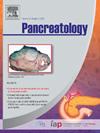胰腺实质体积测量预测浸润性导管内乳头状黏液性肿瘤。
IF 2.7
2区 医学
Q2 GASTROENTEROLOGY & HEPATOLOGY
引用次数: 0
摘要
背景:强烈建议对导管内乳头状粘液瘤(IPMN)合并高危污斑(HRS)进行手术切除。然而,对于老年患者或有多种合并症的患者,做出这一决定是具有挑战性的。在这种情况下,对于具有较高恶性潜能的IPMN,如侵袭性IPMN,可能更适合考虑手术治疗。在这项研究中,我们探讨了胰腺实质体积(PV)测量在预测侵袭性IPMN中的意义。方法:我们回顾性地利用了一个数据库,该数据库包括2000年1月至2018年12月期间162例连续切除的IPMN病例。通过对比增强计算机断层扫描描绘PV,使用Ziostation2软件进行量化,并根据中位数分为高和低类别。结果:中位PV为36.40 cm3,范围为5.07 ~ 87.69 cm3。低PV与侵袭性IPMN显著相关(多变量优势比,2.63;95%置信区间为1.22-5.68;P = 0.01)。HRS对侵袭性IPMN分类的特异性和准确性随着PV测量的增加而增加(特异性;HRS对HRS和低PV: 32.2%[38/118] ~ 71.2%[84/118],准确率;HRS对HRS和低PV: 43.9%[74/162]至67.9%[110/162])。此外,与低级别和高级别发育不良患者相比,侵袭性IPMN患者的PV随时间显著下降(9.09 cm3/年vs. 2.79 cm3/年,P < 0.01)。结论:量化PV,特别是与HRS结合,可以提高侵袭性IPMN的诊断准确性。此外,在监测期间观察到的PV变化可能提供进一步了解进展为侵袭性IPMN的风险。本文章由计算机程序翻译,如有差异,请以英文原文为准。
Pancreatic parenchymal volume measurement for predicting invasive intraductal papillary mucinous neoplasm
Background
Surgical resection is strongly recommended for intraductal papillary mucinous neoplasm (IPMN) cases with high-risk stigmata (HRS). However, it is challenging to make this decision for elderly patients or those with multiple comorbidities. In such cases, it may be more appropriate to consider surgery for IPMN with higher malignancy potential, such as invasive IPMN. In this study, we investigated the significance of pancreatic parenchymal volume (PV) measurement in predicting invasive IPMN.
Methods
We retrospectively utilized a database comprising 162 consecutive resected IPMN cases between January 2000 and December 2018. PV, delineated through contrast-enhanced computed tomography scans, was quantified using Ziostation2 software and stratified into high and low categories based on the median value.
Results
The median PV was 36.40 cm3, ranging from 5.07 cm3 to 87.69 cm3. Low PV significantly correlated with invasive IPMN (multivariable odds ratio, 2.63; 95 % confidence interval, 1.22–5.68; P = 0.01). The specificity and accuracy of HRS for classifying invasive IPMN increased with the addition of PV measurement (specificity; HRS to HRS and low PV: 32.2 % [38/118] to 71.2 % [84/118], accuracy; HRS to HRS and low PV: 43.9 % [74/162] to 67.9 % [110/162]). Additionally, a significant decline in PV over time was observed in cases of invasive IPMN compared to those with low-grade and high-grade dysplasia (9.09 cm3/year vs. 2.79 cm3/year, P < 0.01).
Conclusions
Quantifying PV, particularly when combined with HRS, may improve diagnostic accuracy for invasive IPMN. Furthermore, changes in PV observed during surveillance may provide additional insight into the risk of progression to invasive IPMN.
求助全文
通过发布文献求助,成功后即可免费获取论文全文。
去求助
来源期刊

Pancreatology
医学-胃肠肝病学
CiteScore
7.20
自引率
5.60%
发文量
194
审稿时长
44 days
期刊介绍:
Pancreatology is the official journal of the International Association of Pancreatology (IAP), the European Pancreatic Club (EPC) and several national societies and study groups around the world. Dedicated to the understanding and treatment of exocrine as well as endocrine pancreatic disease, this multidisciplinary periodical publishes original basic, translational and clinical pancreatic research from a range of fields including gastroenterology, oncology, surgery, pharmacology, cellular and molecular biology as well as endocrinology, immunology and epidemiology. Readers can expect to gain new insights into pancreatic physiology and into the pathogenesis, diagnosis, therapeutic approaches and prognosis of pancreatic diseases. The journal features original articles, case reports, consensus guidelines and topical, cutting edge reviews, thus representing a source of valuable, novel information for clinical and basic researchers alike.
 求助内容:
求助内容: 应助结果提醒方式:
应助结果提醒方式:


